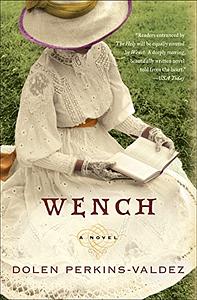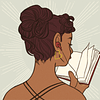Take a photo of a barcode or cover
Meh. It's fine. It's a quick, easy, somewhat interesting read. Too many underdeveloped characters. Too many characters that we've met before. Overall it's a heavy subject done as a light read. Not particularly satisfying. But I didn't put it down.
I hate reading about slavery or anything connected to it. It makes me uncomfortable, sad and angry bu t I read it at the suggestion of my BFF. I have to say I have rarely been more disappointed with the ending of a book than I was wiht this one
I really enjoyed this story and I'm glad it sheds light on a part of slavery I had never known much about, but I only give it three stars because I don't feel like it ends or I guess I just found it a very unsatisfying end. That aside, it was a gripping story, but very sad and hard to read at times.
NK Book Club June 2012
NK Book Club June 2012
Wench by Dolen Perkins-Valdez was fine. It is the story of Lizzie, a house slave and her master’s wench, who gets to go with her Master each summer to a resort in Ohio. She and her fellow slaves deal with the tantalizing nearness of freedom while out of the South and the pull of families and lives back on their various plantations.
This book was not a complete success for a few reasons – there was a significant jump in time in the narrative, which I found really annoying and unnecessary. Lizzie as a character just didn’t make sense to me in many ways, especially her naïveté about how she will be treated by her master as various conflicts rise and her interactions with her fellow slaves both at home and at the resort.
Wench might be a good book club pick for groups looking for a Color Purple read-alike that won't tax the more obtuse members of the discussion.
This book was not a complete success for a few reasons – there was a significant jump in time in the narrative, which I found really annoying and unnecessary. Lizzie as a character just didn’t make sense to me in many ways, especially her naïveté about how she will be treated by her master as various conflicts rise and her interactions with her fellow slaves both at home and at the resort.
Wench might be a good book club pick for groups looking for a Color Purple read-alike that won't tax the more obtuse members of the discussion.
Ahoy there me mateys! For those of ye who are new to me log, a word: though this log’s focus is on sci-fi, fantasy, and young adult, this Captain does have broader reading tastes. Occasionally I will share some novels that I enjoyed that are off the charts (a non sci-fi, fantasy, or young adult novel), as it were. Today I bring ye a historical fiction. This book was part of the booty haul of 2016 and it was exciting to read another book off that list.
This novel is set in Ohio before the U.S. Civil War and takes place at Tawawa House, a summer resort (that actually existed). It is a complicated place because though the area had anti-slavery sentiment, the retreat is known to be a place where Southern slaveholders can bring their black slave mistresses and leave the wives behind. This juxtaposition of the free blacks and slaves at a resort is what lead me to pick up the book.
The book portrays four slave women who come to the resort every year. Lizzie, Reenie, and Sweet are friends tied together by their circumstances. While they have varying relationships with their owners, they look forward to the trip to see each other and have some autonomy over their days when the men are out hunting or camping. Their dynamic changes when Mawu arrives.
Mawu is not complacent and has high self-esteem despite her situation. She brings new ideas to the other women and is especially keen on the idea of running. Lizzie and Sweet have children back home and don't want to leave them. And Mawu seems likely to get them all in trouble.
This book is full of complicated relationships and emotions. I grew to really care about the four women. While I am glad I read this book, I cannot say that it was enjoyable. Reading about slavery, subjugation of the female body, etc. is uncomfortable at best and horrifying at many, many points of the novel. And learning at the end of the book that this specific place did in fact exist was even more heart wrenching. The small highlight was the resort was a real part of the underground railroad and the property was purchased in 1856 and turned into Wilberforce University, the nation's oldest private historically African American institution of higher education. I also appreciated learning about the lives of free blacks in the area though it is not the focus.
This book is recommended if the reader can stomach the subject matter. The novel really does show the complexities and evil of slavery through the lens of slave women who have strength and intelligence. I am also glad the book led me to explore the history of yet another hidden element of the story of slavery in the U.S. Letting those truths not be forgotten is worthwhile. Arrr!
This novel is set in Ohio before the U.S. Civil War and takes place at Tawawa House, a summer resort (that actually existed). It is a complicated place because though the area had anti-slavery sentiment, the retreat is known to be a place where Southern slaveholders can bring their black slave mistresses and leave the wives behind. This juxtaposition of the free blacks and slaves at a resort is what lead me to pick up the book.
The book portrays four slave women who come to the resort every year. Lizzie, Reenie, and Sweet are friends tied together by their circumstances. While they have varying relationships with their owners, they look forward to the trip to see each other and have some autonomy over their days when the men are out hunting or camping. Their dynamic changes when Mawu arrives.
Mawu is not complacent and has high self-esteem despite her situation. She brings new ideas to the other women and is especially keen on the idea of running. Lizzie and Sweet have children back home and don't want to leave them. And Mawu seems likely to get them all in trouble.
This book is full of complicated relationships and emotions. I grew to really care about the four women. While I am glad I read this book, I cannot say that it was enjoyable. Reading about slavery, subjugation of the female body, etc. is uncomfortable at best and horrifying at many, many points of the novel. And learning at the end of the book that this specific place did in fact exist was even more heart wrenching. The small highlight was the resort was a real part of the underground railroad and the property was purchased in 1856 and turned into Wilberforce University, the nation's oldest private historically African American institution of higher education. I also appreciated learning about the lives of free blacks in the area though it is not the focus.
This book is recommended if the reader can stomach the subject matter. The novel really does show the complexities and evil of slavery through the lens of slave women who have strength and intelligence. I am also glad the book led me to explore the history of yet another hidden element of the story of slavery in the U.S. Letting those truths not be forgotten is worthwhile. Arrr!
Fascinating. Review here: http://bookreporter.com/reviews2/9780061706547.asp






